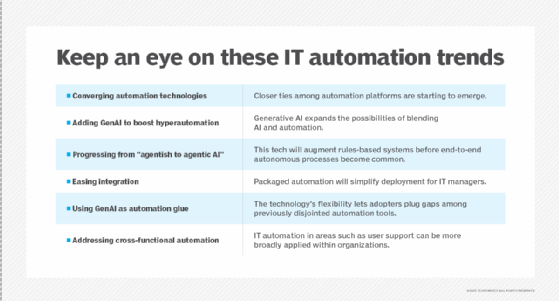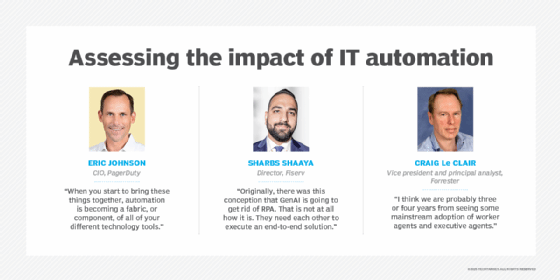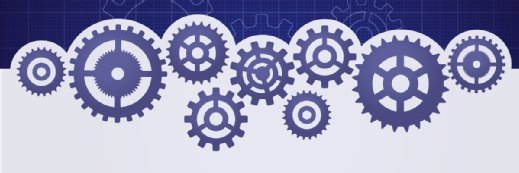6 IT automation trends to watch in 2025 and the future
Trends reshaping IT automation include the convergence of formerly distinct platforms, the role of generative AI as automation glue and the stepwise expansion of agentic AI.
IT managers have been pushing to automate whatever they can as their oversight responsibilities spread across in-house data centers, cloud platforms and edge computing.
Accordingly, they have turned to IT automation to manage the expanding technology universe and drive efficiency. The goal is to automate manual, repetitive tasks in such areas as infrastructure management, service management, cybersecurity and application deployment. The potential benefits include cost reduction, higher productivity and faster problem resolution.
But the promise of IT automation comes with challenges. The widening scope of enterprise technology has led to a proliferation of tools, including scripting languages, robotic process automation (RPA), digital process automation (DPA), low-code/no-code platforms, IT service management suites and workflow automation products. Technology managers have been minding the gaps between automation tools.
"This has been years in the making," said Eric Johnson, CIO at digital operations management software provider PagerDuty. "We've been trying to figure out how to harness the power of automation. Historically, we were trying to play around with different pieces of technology and gluing them together."
Developments shaping IT automation
Technology and business developments, however, are reshaping IT automation. Notably, the growing influence of artificial intelligence is bringing new capabilities to existing automation toolsets and introducing new options. Indeed, generative AI (GenAI) and agentic AI are poised to play a critical role in automating IT operations and bridging formerly disparate systems.
On the business side, corporate managers beyond the IT shop are showing more interest in automating their key processes, opening opportunities for CIOs and other technology leaders to offer their automation expertise to a wider internal customer base. Six IT automation trends, in particular, bear watching.
1. Converging automation technologies
Fragmented automation, while not quite a thing of the past, is showing signs of lessening. "A lot of these techs are starting to converge," Johnson said, noting that the trend got underway 12 to 18 months ago. He cited GenAI as an example. The technology's initial focus was on answering questions and productivity use cases such as writing code and drafting email messages. But GenAI is starting to link with the automation world, he noted.
OpenAI's Operator, for instance, is an AI agent that can take actions on a user's behalf. The company launched the tool in January as a research preview and plans to eventually include Operator capabilities in ChatGPT. "When you start to bring these things together," Johnson explained, "automation is becoming a fabric, or component, of all of your different technology tools."
While GenAI takes on automation, automation products such as RPA integrate with AI. As a result, RPA is transitioning from a strictly rule-based system targeting repeatable tasks to a platform that adapts to its environment. Traditional RPA vendors realize they need to "manage things in a more dynamic way," Johnson noted.

2. Adding GenAI to boost hyperautomation
The combination of RPA and AI, along with machine learning (ML) and other tools such as process mining, has created yet another automation category: hyperautomation. The technology's goal is to scale automation within the enterprise and tackle more end-to-end processes. Hyperautomation isn't new -- Gartner coined the term in 2019 -- but it's taking on greater importance for a couple of reasons.
First, the economic uncertainty of recent years has highlighted the need for operational efficiency, raising hyperautomation's profile. Second, GenAI and other AI advances, which boost intelligent automation, have captured buyers' attention. Gartner cited a "resurgence" in demand for hyperautomation since GenAI technology hit the mainstream in 2022.
Financial services technology firm Fiserv is using hyperautomation to extract service level agreement (SLA) data from contracts. The company sought to automate that painstaking, manual process but ran into limitations with ML. The ability to add GenAI to automation, however, made the data extraction use case possible.
"The challenge we had prior to GenAI is that you can't train the ML models to track something like this," said Sharbs Shaaya, director of enterprise AI-powered automation at Fiserv. The models weren't able to find data buried in the middle of paragraphs or otherwise scattered throughout contracts. "This is something we are now able to do," Shaaya added.
Fiserv uses AI agents that delve into contracts and extract SLA data such as performance metrics and the fees vendors agree to pay for falling short of those measures. The data is transferred to a UiPath RPA bot, which continues the execution of the SLA process.
Shaaya said he is applying the same hyperautomation approach to extracting financial agreements within contracts. The project, still in the research and development phase, aims to pull out fees associated with clauses such as Consumer Price Index agreements and reconcile them with customer invoices, he explained. An AI agent, for example, might find that a vendor's CPI agreement stipulated an annual 3% increase, but that rise in billing rate wasn't reflected in some invoices.
3. Progressing from 'agentish to agentic AI'
Agentic AI acts autonomously, handles decision-making without human intervention and seems like a natural fit for automating IT and other business processes. The technology is expected to make enterprise inroads in 2025, but the widespread adoption of fully autonomous processes is unlikely to occur immediately.
Craig Le Clair, vice president and principal analyst at Forrester, said he sees a stepwise progression from "agentish to agentic AI." In the agentish phase, deployments will typically rely on deterministic process engines and use agents as needed to increase efficiency. "To me, that is not an agentic process because the model is not in control of the entire process," he said.
Le Clair described the not-quite-agentic offerings as "solver agents." The next step up will be the worker-agent stage, in which the AI model takes over the entire job. Eventually, executive agents will emerge to manage automation chores across multiple agents. "I think we are probably three or four years from seeing some mainstream adoption of worker agents and executive agents," Le Clair surmised.
4. Easing integration
Automation platforms, buoyed by convergence, are getting easier to integrate, since much of the heavy lifting is already done. Johnson pointed to the example of building a conversational agent to answer user support questions. It was a fairly complex task just a couple of years ago.
"There was a lot of blocking and tackling you had to do behind the scenes around managing the content, building out pieces of automation and workflow," he said. "The pieces were there, but it was like a jigsaw puzzle."
Yet the GenAI chatbots emerging since the second half of 2024 have shown considerable progress, Johnson noted. "These tools are pretty intelligent and pretty easy to set up, use and manage," he said. "It's all one package as opposed to having a bunch of different technologies you have to stitch together."

5. Using GenAI as automation glue
AI stands out as the common denominator in automation's convergence. GenAI, in particular, helps tech organizations glue together formerly isolated pieces of automation. The technology facilitates the automation of entire processes -- and cooperates with traditional tools.
"Originally, there was this conception that GenAI is going to get rid of RPA," Shaaya said. "That is not at all how it is. They need each other to execute an end-to-end solution."
In past years, Shaaya's team would automate as much of a process as possible but would hit limitations when a step required a human to analyze input or output. But with GenAI, the team can build more comprehensive automations, rather than addressing only the rules-based portions of a process.
Fiserv's back-office operations, such as its call center, are seeing the biggest benefits from expanded process automation. For those operations, Shaaya noted, the value of solving even a simple problem becomes magnified due to the high transaction volumes involved.
6. Addressing cross-functional automation
Automation can improve the efficiency of a broad spectrum of IT processes, from provisioning servers to responding to security incidents. But some tech processes, such as user provisioning and service management, have customer service analogs in other parts of the business.
Against that backdrop, IT managers have an opportunity to provide their automation approaches to other corporate functions. Technologies such as large language models, natural language processing and virtual agents have ramped up the efficiency of level 1 support: dealing with users' basic questions. Now, there's an opening to extend that benefit beyond IT.
"We are looking at, 'Can we do level 1 support in an automated way for the entire company?'" Johnson said, adding that he's exploring opportunities to automate support for any corporate group that fields questions -- legal, procurement and HR, for example. The initiative kicked off last year, when PagerDuty's executive team started to mention automation in discussions. "I think they are starting to realize, 'Hey, there is all this good tech out there and all this opportunity to become way more efficient with how we run the company. We all need to participate,'" Johnson said.
The future of automation
The trends currently in motion suggest several directions for IT automation. Here's the rundown:
- Agentic process orchestration. The next process platform will include aspects of RPA, DPA, integration platform as a service and low-code technologies, Le Clair noted. That platform will focus on orchestration, agent-building via prompts and new forms of governance dealing with the good and bad things agents can do.
- 'BOAT' on the horizon. Business orchestration and automation technologies, or BOAT, is Gartner's take on the future of automation. The market researcher said RPA, business process automation and other products are moving toward BOAT as a common automation architecture.
- Self-service automation. At Fiserv, Shaaya said the company has been enabling tech-savvy business users to build their own automations using RPA software. The next goal, he noted, is to help these users build automations that incorporate GenAI components. Fiserv's move is part of a broader movement: In its "Predictions 2025: Automation" report, Forrester predicted that citizen developers will construct 30% of "GenAI-infused automation apps" this year.
Business and technology leaders can expect to see a higher level of integration among automation toolkits that will take on a wider swath of business processes.
John Moore is a writer for Informa TechTarget covering the CIO role, economic trends and the IT services industry.








